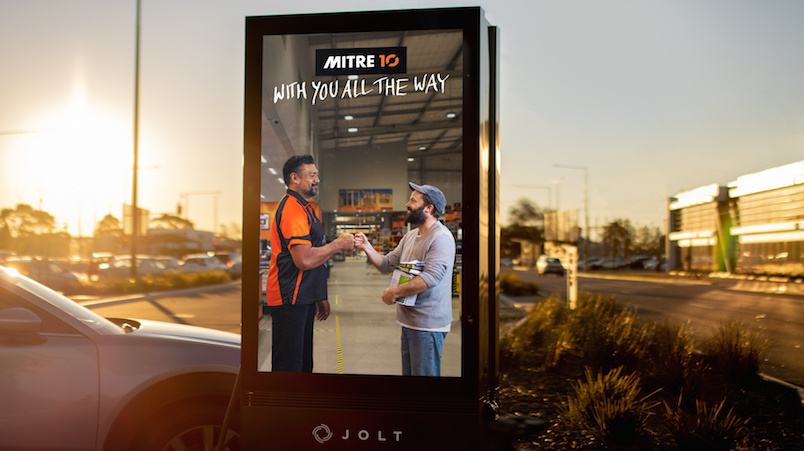Jolt expands as banks, retailers drive decarbonisation through supply chains, look beyond offsetting

Electric vehicle charging and digital out of home network Jolt, backed by $100m from BlackRock, has expanded into New Zealand as its Australian operation starts to attract tier one brands looking to make a greater contribution to decarbonisation and go beyond offsetting the carbon footprint of their ads.
What you need to know:
- EV charging and digital out of home advertising network has launched in New Zealand with former QMS NZ CEO and Ambient Group founder Chris Monaghan leading the local business.
- In Australia, advertiser demand is heating up, per Head of Sales and Platform, Michael Selden, with tier one advertisers including Woolworths and Macquarie joining Telstra, CommBank, Audi and fintech platform Stake. Volvo-owned dedicated EV brand Polestar is also going to market.
- As the media supply chain races for ESG metrics and carbon calculators, Selden said brands are also looking for ways to drive decarbonisation beyond offsetting ad footprints.
When we first launched locally, I thought we might be a little early on the advertising side. But that’s not the case at all.
BlackRock-backed Jolt has expanded into New Zealand as brands step-up mandates to decarbonise supply chain partners beyond media and advertising.
The electric vehicle charging and outdoor advertising network is building out its New Zealand footprint starting in Auckland, with Mitre 10 onboard as a founder advertising partner and former QMS NZ CEO Chris Monaghan leading the local business.
Jolt's Australian network build-out continues as demand from brands heats up.
BlackRock’s investment is underpinning that rollout. The world’s largest asset fund, with USD$10 trillion under management, largely pension funds seeking stable, sustainable, long-term returns, took a minority stake in Jolt last August, committing AU$100m to help fund 5,000 electric vehicle charging points by 2030, by which point NSW and Victoria have committed to halve carbon emissions. After energy, including upstream production and power generation, transport is Australia's second largest carbon emitter.
Jolt’s Michael Selden said the firm aims to help brands decarbonise the economy beyond media supply chains. It is building out assets that enable carbon neutral advertising while also driving down transport emissions as Australia appears set to align more closely with global markets mandating steep carbon reduction targets.
Australian EV sales tripled in 2021, and YoY increased 112 per cent in May, per Vfacts data, but remain a tiny proportion of overall sales. Part of that is availability, as carmakers ship units to markets where policy, incentives, and demand align. Would be EV buyers often face 18-month wait times in Australia, but public charging infrastructure is a critical market enabler and far from an overnight proposition, given planning, civil and electrical engineering requirements alongside high capital investment and demand-risk management.
Jolt though remains confident of hitting long-term charger numbers, while advertisers are driving demand for the screens network now rolling out in NSW and Victoria alongside more established penetration in South Australia.
Media mobilising
Media agencies are racing to bring carbon calculators and ‘ESG metrics’ to market as brands call on suppliers to align with their sustainability mandates.
While Telstra has been most vocal, Selden said more tier one advertisers are now briefing Jolt’s ad business, with the likes of Woolworths and Macquarie joining CommBank, Audi and fintech platform Stake. Volvo-owned dedicated EV brand Polestar is also going to market.
“Some of those brands are buying us as a premium reach extension for out of home buys, others are buying us for contextual relevance in and around sustainability,” said Selden, with Macquarie, for example, pushing EV loans.
“Decarbonising media through carbon offsetting is a vital step. But brands are also looking for ways to make a deeper contribution and actively reduce emissions. That is the business we are building here and around the world,” he said.
“When we first launched locally, I thought we might be a little early on the advertising side. But that’s not the case at all.”
